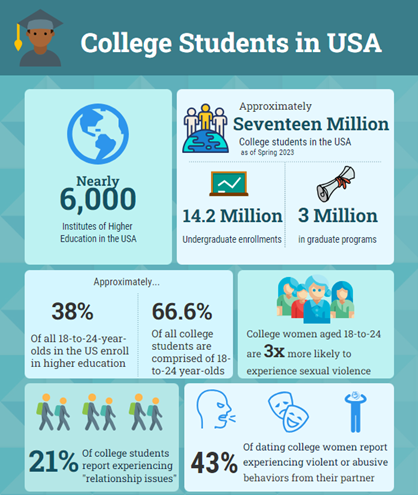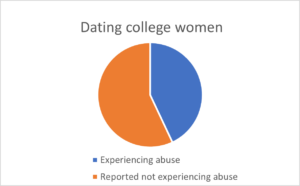Violence prevention efforts are vital to reduce, and ultimately end, domestic violence. There are many important objectives in this work- for Campus Safety Awareness month (September), ICADV is focusing our prevention efforts on higher education. In this piece, we want to focus on why violence prevention in higher education is so important and greatly needed. This issue is especially relevant at the beginning of the school year, as more than 50% of sexual violence incidents occur in August, September, October and November.

(infographic resources linked below)
1) There are roughly 17 million college students in the USA.
That’s a lot of people! As depicted above, 21% of students reported having “relationship problems” in The 2014 National Survey of College Counseling Centers. 21% of seventeen million is 3,570,000 students! Violence prevention efforts could help 3,570,000 human beings across college campuses maintain healthy relationships instead of harmful ones.
2) Of these 20 million students, most of them belong to a vulnerable age group.
According to the Network for Victim Recovery of DC (NVRDC), 18 to 24-year-olds are the most at-risk age group for domestic violence. 18–24-year-olds are the majority of college students, constituting 66.6% of the student population. Therefore, it is our duty in the field of domestic violence to implement and maintain violence prevention and intervention efforts in higher education. When dating college women were surveyed by The National Coalition Against Domestic Violence (NCADV), 43% reported “experiencing violent or abusive behaviors from their partner.

In an Association of American Universities (AAU) survey that truly emphasizes the need for violence prevention services in higher education, 70% of students who reported being in an abusive relationship did not realize it at the time. Increased prevention efforts would diminish social, educational, and psychological barriers to recognizing the signs of abuse and seeking help. In this same study, 60% of students in an abusive relationship said no one tried to help them at the time, and 57% surveyed that dating abuse is very or moderately difficult to identify. This data demonstrates that there is a strong need for more domestic violence advocacy and education on college campuses.
Other factors that make college students vulnerable are the stressors that most are experiencing for the first time. These stressors include self-sustaining practices like cooking, cleaning, paying bills and personal accountability- especially maintaining their school-related requirements. Another stressor of college life is living closely with another person/people, most of whom are strangers. Meaning, college students will be building their social connections and support systems, and may be vulnerable to people seeking power and control. This stressor is especially dangerous for students who do not get along with their roommate(s)- a student may stay with a harmful partner to avoid conflict with roommates. In addition to these stressors, college students are experiencing distance between them and their friends and family for the first time. That homesick feeling may lead someone to look past their partner’s warning signs or explicit abuse to maintain a familiar relationship. Last but certainly not least, many college students experiment with drugs and alcohol for the first time and may be unaware of the risks to their safety. As many of us know, drugs and alcohol can heighten emotions and impair judgment and decision-making abilities leading to dangerous situations. According to American Addiction Centers, drugs and/or alcohol are involved with 40-60% of domestic abuse cases. All of these stressors tell us that students need multi-faceted support to fully engage and excel in their college career, including education on domestic abuse and comprehensive community resources. When colleges engage in violence prevention efforts, students are more aware of these resources and may feel safer accessing them.
Finally, many college students are vulnerable due to immensely prevalent mental health concerns across campuses– and who can blame them with all the stressors in their lives? In the previously mentioned AAU survey, 61% of students reported being depressed. Depression can be caused or amplified by domestic and sexual violence. Additionally, the symptoms of depression may lead someone to accept or feel deserving of intimate partner violence. College students need easily accessible support to navigate all the changes and stressors during this time in their lives, including services from their local domestic violence agency.
3) A heightened culture of toxic masculinity within male sports and fraternities on campus contributes to violence committed by and endured by college students.
People are affected and influenced by the social structures in which they exist. Male athletes and campus fraternities are a prime example of this social conditioning, as they too are victims of toxic masculinity. Toxic masculinity condones violence and aggression while dismissing mental health concerns. Additionally, this ideology includes the degradation of women. For example, “you throw like a girl” or locker room talk. This culture within male athletics and fraternities contributes to sexual and intimate partner violence on college campuses.
I was fortunate enough to conduct an interview with an insider- a staff member at a large, public university whose work is directly related to intimate partner violence prevention and education. For anonymity purposes, let’s call them Jamie.
First, we talk about male gender roles through the lens of toxic masculinity. Jamie identifies male athletes and fraternity members as being especially vulnerable to the ideologies of toxic masculinity. One consequence of this ideology is a culture of domination, creating a burden to prove one’s manliness or capability to lead. Women, and the sexual conquest of their bodies, are a prime outlet to showcase this manhood. This culture of dominance is proven by ideas like rapebait, instructions for fellow frat brothers on how to lure women at parties. Domination is just one aspect of toxic masculinity that contributes to gender-based violence (GBV) in higher education. Additionally, this perception of masculinity compels many men to remain silent about incidents of violence against them. This is a culture that harms everyone.
Next, we talk about the minimal education that young men receive on GBV. College administrations, coaches and guardians have a responsibility to educate boys and men. Strongly enforced policies and programs are more effective than one-time trainings. Unfortunately, there is only a brief one-size-fits-all training required at the beginning of each school year to educate college students on consent and violence. College athletes and fraternities are required to do an additional yearly training, but in Jamie’s experience, not all institutions ensure these trainings have been completed. This problem is worsened when coaches and administrations do not enforce a zero-tolerance policy, or any consequences for that matter. In Jamie’s words, “administration has made it very clear they do not care about these issues enough to do something about it.” This lack of accountability is an injustice that is harming all students.
Finally, drawing on their professional experience, Jamie discusses how violence prevention and education takes a village. Meaning, Title IX educators like Jamie can educate students all day long, but if students’ language and behavior do not reflect this knowledge, no progress will be made without reinforcement from admin, coaches, and peers. Furthermore, we have to think about how boys and men are learning- learning from a female educator may be unproductive if they have no respect for women. When college athletes are three-times more likely to receive a sexual misconduct complaint, it is clear that more violence prevention efforts are needed. In Jamie’s experience, some college administrations will turn a blind eye to sexual and domestic violence if those athletes are bringing in the money. Fraternities will also sweep similar instances under the rug to avoid bad publicity. Violence prevention really does take a village- that’s why coaches and administrations need to take a more active role in violence prevention on campus.
I asked Jamie what colleges can do, beyond those minimal requirements, to reduce domestic violence on campus. According to Jamie, one solution lies in staffing- colleges are not properly staffed to accommodate this need on campus. For example, Jamie is one of two in their field at a university of over 15k students. This problem also extends to funding. According to Jamie, their budget is “next to nothing.” Essentially, institutes of higher education need to invest in the issue of sexual and intimate partner violence.
Many institutes of higher education have invested in violence prevention already. They prove their investment through public education, loud advocacy, enforcing strong policies, and implementing prevention specific programming. For example, SUIe offers aid through a Prevention Education and Advocacy Center (PEACe), and NIU and UIUC offer online awareness training. There are many resources available on prevention programming in higher education– it is possible and has the ability to succeed with dedicated leaders.
In conclusion…
College students need multi-faceted, comprehensive support from dv agencies, the community, and staff and faculty at their schools. Violence in higher education can be attributed to many factors specific to college campuses, including distinctive vulnerabilities in conjunction with a harmful culture of toxic masculinity within male athletics and fraternities. These are just some of the reasons why college students would benefit from comprehensive, ongoing education on sexual violence, intimate partner violence, and how to support those experiencing it. In Jamie’s words, “what it comes down to is that the culture needs to change, a complete overhaul. We need a diverse and inclusive admin, not just straight, white men. A university administration that actually cares about [investing in] the safety of students, especially women, people of color, and LGBTQ+ individuals. Until that happens, the same story is going to be told over and over again.”
Violence is preventable.
Invest in violence prevention.
*Infographic resources:
College Enrollment Statistics in the U.S. | BestColleges
How Many Colleges Are in the U.S.? | BestColleges
COE – College Enrollment Rates (ed.gov)
College Student Statistics For 2023 (Data, Facts & Trends) (prosperityforamerica.org)
CTEE_Fall2022_Report | Tableau Public
Campus Sexual Violence: Statistics | RAINN
